#freshwater ecology
Text
Wet Beast Wednesday: spiny softshell turtle
It may be neither Flat Fuck Friday nor Turtle Tuesday, but because this is my series and I can do what I want, I'm talking about a very flat turtle. The spiny softshell turtle (Apalone spinifera) is the most widely distributed and possibly the most common softshell turtle in North America. Its range covers most of the Eastern half of the USA and stretched into Canada and Mexico. There are 6 subspecies separated by geography and hybridization can happen in places where their ranges cross. Hybridization has also been known to happen with the Florida softshell (Apalone ferox). The subspecies are the northern (A. s. spinifera), gulf coast (A. s. aspera), Texas (A. s. emoryi), pallid (A. s. pallida), Guadalupe (A. s. guadalupensis), and black (A. s. atra) spiny softshells.

(Image: a spiny softshell turtle seen from above and to the side. It is a turtle with a wide, flat shell. Its head and one foot are visible. The head is skinny and has an elongated nose. The foot is wide and flat, with webbed toes. The turtle is an olive green with black dots on the skin, yellow stripes on the face, and dark spots on the shell. End ID)
The thing that makes a softshell a softshell is the lack of keratinized scutes on their shells. This makes the shells smooth and leathery. The center of the shell has a layer of solid bone user it, but this does not extend to the edges of the shell, making it less rigid. Softshells are the fragile speedsters of the turtle world. Their shells are a lot lighter and often more streamlined, allowing for faster movement both on land and in water, but they provide less defense. Spiny softshells have spiny projections along the front edge of the carapace (upper shell), with males having more than females. They are some of the largest North American freshwater turtles. Females can reach a carapace length of 54 cm (21 in) and 11 kg (25 lbs) while the smaller males max out at about 25 cm (10 in).
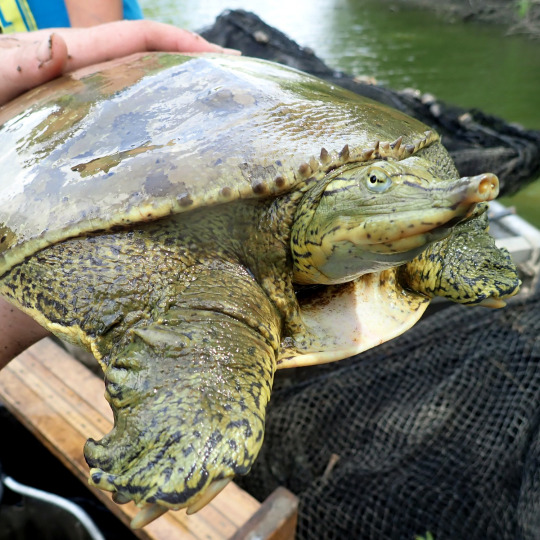
(Image: a spiny softshell being held by a person, seen from the front. The leading edge of the carapace is visible, showing off the small spines. End ID)
Spiny softshells have wide, flat, paddle-like feet with three claws and an elongated nose that acts like a snorkel. The turtles are born a bright olive color with striped faces and dark spots on the shell. Males keep their juvenile coloration for their entire lives while females grow darker ad lose many of their markings. It can be very difficult to tell females of different subspecies apart, while males and juveniles can be distinguished by their markings. Smooth skin and highly vascularized membranes in the cloaca, mouth, and throat allow the turtles to breathe by diffusing dissolved oxygen from the water into their blood.
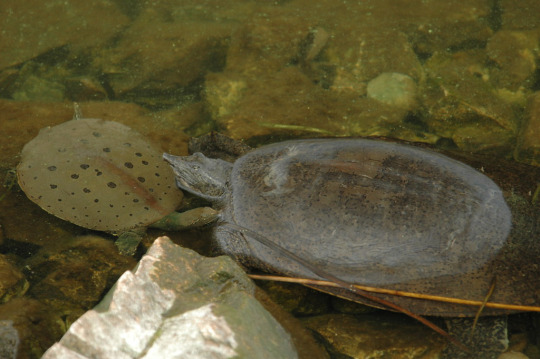
(Image: a male and female spiny softshell facing each other. The male is less than half the size of the female and has an olive colored shell and skin, with dark spots on the shell. The female is a uniform muddy brown color. End ID)
Spiny softshells are generalists able to live in a wide range of habitats. They prefer streams, rivers, and ponds with muddy or sandy bottoms and high visibility, but can live in most freshwater habitats. Softshells are diurnal, spending their days basking and feeding. Being turtles, they are ectothermic, meaning their body temperature matches the surrounding temperature. To warm themselves up, the turtles bask in the sunlight. They can often be found resting on exposed rocks, logs, sandbars, or shorelines. While not particularly social animals, the turtles will bask in groups. When threatened, softshells will attempt to swim away and/or bury themselves. In the right sediment, a softshell can bury itself in under a second. Because their shells are less rigid, softshells have to actively defend themselves when cornered and will bite and scratch. People have to be careful when handling them. They brumate (that's hibernation for reptiles) during winter. While brumating, they bury themselves underwater and slow their metabolism and oxygen requirements. In this state they can fully sustain themselves on oxygen absorbed through their skin or special membranes.
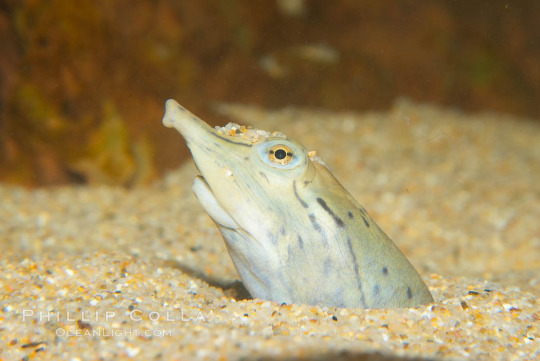
(Image: a spiny softshell turtle buried in its hunting strategy. Only the head is visible above the sand. End ID)
They are primarily carnivores and will eat anything that can fit in their mouths. Aquatic insects, crayfish, worms, amphibians, mussels, snails, fish, and more are on their plate. While capable of fast swimming, they are not pursuit predators. They employ two primary hunting strategies. The first is to bury themselves in the sediment and wait for prey to come by. The second is digging in the sediment to find worms and other animals. Fish have been known to follow digging turtles around to feed on animals unearthed by them.

(Image: a spiny softshell in captivity. It is swimming at the surface of the water in a tank, amongst artificial leaves. End ID)
Spiny softshells mate in spring. Males attempt to woo females by swimming over to them and bumping heads together. The male then sits on top of the female to mate. Unlike most species of turtles, the males do not grab onto the female's shells during mating. Eggs are laid between summer and early fall and will hatch next spring. The female will dig a nest in sandy or gravelly banks and bury the eggs once they have been laid. She provides no further care. Females will typically mate multiple times each year, with each mating having a different nest. The juveniles take 8 to 10 years to reach sexual maturity and they can live up to 50 years in the wild. Many turtles determine sex by the temperature the eggs are incubated in. This is not the case with spiny softshells, who have genetics based sex determination.

(Image: a group of 5 juveniles. The photo focuses on two who are sitting next to each other. One has its front right leg on the shell of the other. They have similar coloration to an adult male. End ID)
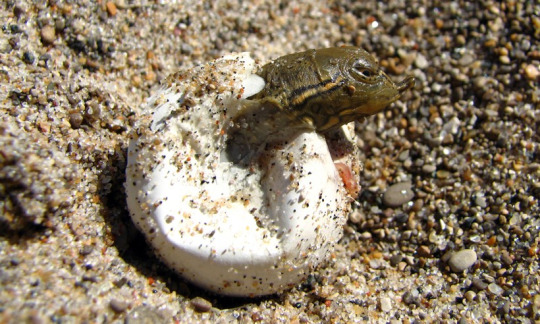
(Image: a newborn emerging from its egg. The egg is round and white, looking like a ping-pong ball. Only the head of the turtle has emerged. End ID)
Most subspecies of spiny softshell are classified as least concern or near threatened by the IUCN, meaning they are not in danger of extinction. The exception is the black spiny softshell, also known as the Cuatro Ciénegas softshell, which is critically endangered. The primary threats to the turtles is habitat loss due to human activity. Adults have no natural predators outside of the Florida and adjacent state populations, which are prey to alligators. Juveniles are eaten by a variety of animals including fish, snakes, raccoons, and herons. People will also eat the adults. Because it can take a whole decade for juveniles to become reproductive, losses in population take a long time to replace. They have been introduced to areas outside of their native range, most notably the western USA. Most of these introductions are due to people releasing pet turtles into the wild.
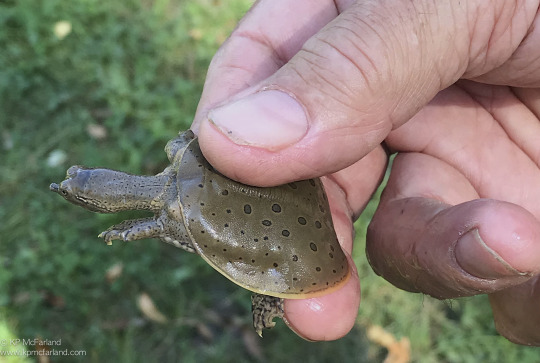
(Image: someone holding a juvenile. The shell is 2-3 times the size of the human's thumb. End ID)
#i typoed it as softhsell more times than I care to admit#wet beast wednesday#turtle#turtles#softshell turtle#soft shell turtle#spiny softshell turtle#reptile#biology#zoology#ecology#animal facts#freshwater ecology#aquatic biology#informative#educational#image described#turtle power#herpetology
45 notes
·
View notes
Text
Zooplankton are tiny crustaceans that occupy a variety of roles in Great Lakes food webs, from open water filter feeding to benthic decomposers 🩵
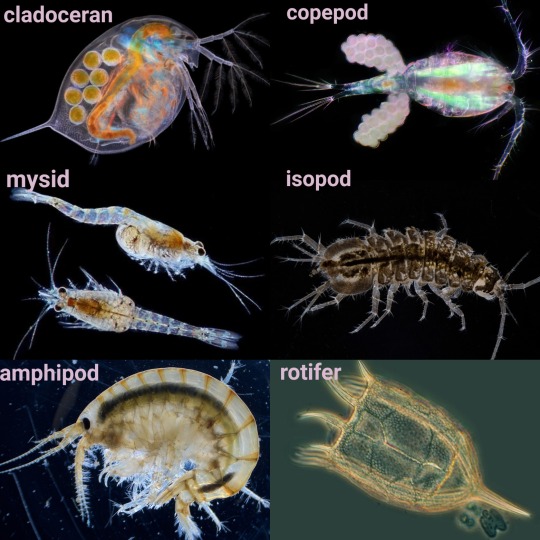
#great lakes#lakeposting#poll#lake#freshwater#freshwater ecology#aquatic ecology#ecology#biology#science#crustaceans#cute#animals#shrimp#freshwater science#limnology#aquatic#plankton#zooplankton#cladocerans#copepods#amphipods#isopods#rotifers#food web#nature#naturecore#microscopic#miniature
476 notes
·
View notes
Text
arapaima gigas
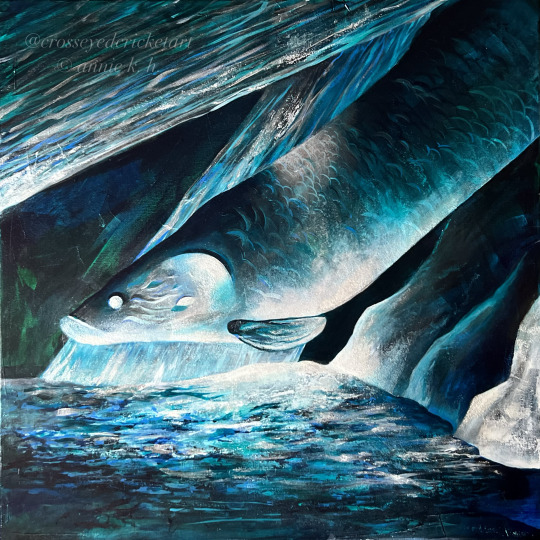
arapaima, river giant.
2023 / 24” x 24” / acrylic and glitter on canvas
arapaimas are some of the largest freshwater fish in the world. this is based off a photo I took in the Tennessee aquarium. this is a painting in inverse, meaning the white is shadow and the dark areas are light.
And with some horrible procreate skills, here’s what it “should look like” with the shadows being dark and the highlights being light:

i did my best don’t bully me I’m bad at digital editing
#art#painting#fish#fishblr#freshwater fish#Arapaima gigas#Arapaima#Freshwater#freshwater ecology#Fishes#fish art#aquatic life#Animals#marine animals#marine art#🖤 art tag
52 notes
·
View notes
Text
I've applied to SERC 5 times now and still haven't even gotten an interview. I exceed the qualifications and I should have priority since I was trained by the Smithsonian. Are the other people applying super geniuses?? Literally its research technician positions and internships. I have over a year's experience as a field tech not including my academic experience. I'm tempted to email the lab manager and ask what training I need for her to hire me.
#wrenfea.exe#working while disabled#SERC is the place to be for aquatic invertebrates#freshwater and marine#maybe they want people with marine biology degrees??#i have an environmental sci degree but Ive taken a ton of marine science classes#hey if any of my followers work at SERC#pls...let me in..#marine biology#freshwater ecology#fishblr#invertebrates#marine science
41 notes
·
View notes
Text

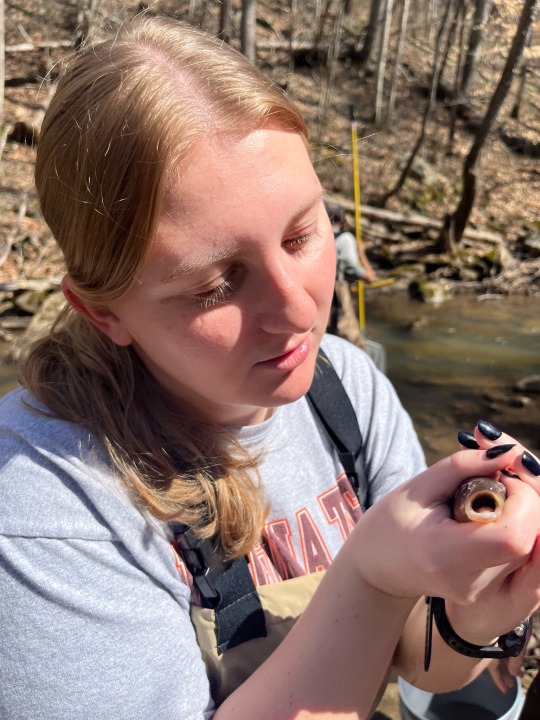

zapped them fish and snagged them crawdads
0 notes
Text



A Shoo-in Shoebill Stork
The shoebill stork, also known as the whalebill stork or Balaeniceps rex is in fact not a stork at all, but a long-legged wading bird belonging to the family Pelecaniformes. This species can be found in the central African tropics, from southern Sudan to northern Tanzania. Within this range, they mainly inhabit freshwater swamps and dense marshes, particularly those with deep water large reed beds.
Balaeniceps rex is often referred to as a dinosaur among birds due to its fearsome appearance. The average individual stands 1.1-1.4 m (3.6-4.5 ft) tall and has a wingspan of 2.3 to 2.6 m (7.5 to 8.5 in). However, adults are quite light, weighing only 4 to 7 kg (8.8 to 15.4 lb). Males tend to be larger than females, but otherwise the two sexes look identical. Adults have dark grey plumage with a lighter belly and darker wings. Their most striking feature is their beak, which is extremely large and can be said to resemble a wooden show (hence the name).
The shoebill's beak is very useful for catching its primary prey: fish. B. rex consumes a variety of species, including lungfish, catfish, and tilapia, as well as non-fish items like water snakes, frogs, turtles, mollusks, and even young crocodiles. Shoebills typically stalk their prey, or stand perfectly still and wait for their prey to come to them, before quickly snatching it up and decapitating it with the sharp edges of their beaks. Because of their large size and strong bills, adults are seldom prey for other animals, and they defend their nests fiercely from predators like snakes and other birds.
Outside of the breeding season-- and even during it-- shoebills are extremely territorial. Not only do they chase potential predators away from their nests, both males and females will fiercely defend their territory from other shoebills.
Breeding begins in the dry season, typically in in May, and lasts until about October. Once a male and female form a pair, they remain together for the duration of the mating season. They build a nest from floating vegetation, and 1-3 eggs are cared for by both parents; in addition to being incubated for warmth, one parent may also occasionally pour a beak-full of water over the eggs to keep them cool during the hot summer day. The eggs hatch about 30 days after being laid, and young are fed continuously-- though usually only one chick survives to adulthood. At 125 days old they become fully independent and leave to establish their own territories. The average individual can live up to 35 years in the wild.
Conservation status: The IUCN lists the whalebill stork as Vulnerable. Current wild population estimates sit at about 5,000-8,000 individuals. Primary threats include poaching for the zoo trade and consumption, habitat destruction, and pollution.
If you like what I do, consider leaving a tip or buying me a kofi!
Photos
Santiago Caballero Carrera
George Amato
Mana Meadows
#shoebill stork#Pelecaniformes#Balaenicipitidae#wading birds#birds#wetlands#wetland birds#freshwater fauna#freshwater birds#africa#central africa#animal facts#biology#zoology#ecology
160 notes
·
View notes
Text




earth fact time. devil's hole pupfish are the rarest fish on earth. they are also the most inbred fish on earth! they live in ONE place, a hole in the ground called devils hole in nevada. and the thing is they can only survive in that hole, which is 93Fº. literally no other fish can survive in those conditions.
because of their tiny environmental niche, they're critically endangered, so there's a program working to breed them. but the thing is that these guys evolved SO WELL that the conditions they live in have to be exactly like devils hole, or else they straight-up just die, so scientists have needed to replicate the devils hole environment for them to survive.
last year science hippies counted 263 fish, which is a 19-year high!
npr | national park foundation | national wildlife federation | phys.org
photos from usfws national digital library, taken by olin feuerbacher
#aquatic#earthposting#facts!#marine biology#biology#marine life#freshwater fish#marine animals#zoology#fishblr#fish#marine ecology#ichthyology#devils hole pupfish#earth fact no. 15
156 notes
·
View notes
Text

Wimple Piranha (Catoprion mento)
Family: Serrasalmid Family (Serrasalmidae)
IUCN Conservation Status: Least Concern
A tiny (15cm/5.9 inches in length) relative of the more famous Red-Bellied Piranha, the Wimple Piranha is found in the Amazon, Orinoco, Paraguay and Essequibo river basins, and is notable for its unusual diet; adults of this species feed almost exclusively on fish scales, feeding by ramming into larger fish at high speeds with their mouths wide open, biting and generating suction to dislodge their target’s scales and pull them into their mouths. The practice of eating scales, known as lepidophagy, is rare in animals as scales are difficult to digest and require considerable amounts of energy to obtain, and it is likely that it developed in response to the intense competition between fish species in the biodiverse rivers to which Wimple Piranhas are native - although their nutrients-poor diet limits their size, feeding exclusively on scales (occasionally supplemented by small insects or small amounts of the meat of their otherwise unharmed targets where possible) allows Wimple Piranhas to find food while largely avoiding competing with larger and less specialised carnivores. Besides their unusual feeding habits little is known about the biology of wild Wimple Piranhas, although through the observation of captive individuals it has been found that unlike many piranha species they are solitary (possibly avoiding living in groups to avoid competing with other members of their species,) and that like other members of their family females of this species lay eggs.
--------------------------------------------------------------------------
Image Source: https://www.inaturalist.org/taxa/342485-Catoprion-mento
#Wimple Piranha#piranha#piranhas#fish#fishes#zoology#biology#icthyology#animal#animals#wildlife#South American wildlife#freshwater fish#bony fishes#bony fish#aquatic wildlife#evolution#ecology
102 notes
·
View notes
Text
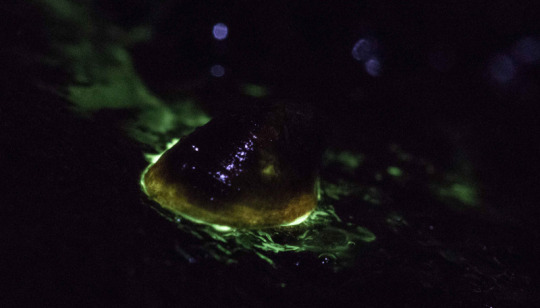
Okay, okay. I know this isn't a marine animal but I recently read about this little beauty and decided that you all should be informed as well.
As it turns out the 'normal looking guy who is secretly kind of a freak' trope is not exclusive to the human species.
This unassuming 11cm gastropod has a hidden talent, it is possibly the only freshwater snail known to science with the ability to produce bioluminescence.
Like most 'limpets', the luminescent limpet (Latia) absolutely love scraping organic matter and algae off rocks. This amazing specimen however, can generate a glowing slime as a defense mechanism when disturbed.
They are also real homebodies, only being found in stony stream systems of the north island (Te Ika-a-Māui) of the country of New Zealand. In between these marvelous critters and the native glow worm (Arachnocampa luminosa) you would be forgiven for imagining the NZ wilderness as some kind of green-tinted nighttime rave.
These sensitive little souls however are currently at risk due to declining water quality New Zealand rivers.
Photo: Shaun lee
#wet beast wednesday#molluscs#freshwater#gastropods#snail#zoology#ecology#ecosystem#bioluminescence#bioluminecent
23 notes
·
View notes
Text
The more you learn about freshwater ecology, the more you will start to hate dams with the fiery passion of a thousand hateful suns
#stop fucking up streams and rivers#you're preventing migration#restricting nutrient flow#killing species#and generally making things worse#freshwater ecology#freshwater biology#ecology#dam
150 notes
·
View notes
Text
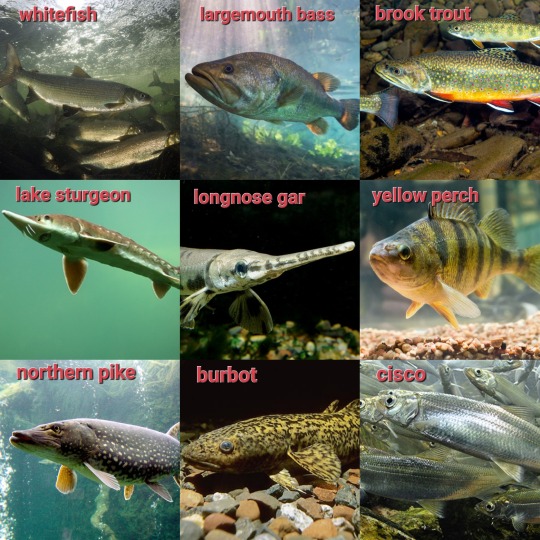
Please add other Great Lakes fish I have missed in the tags if they're you're favorite 🐟🩵 also note these are fishes native to the Great Lakes which is why no salmon
#fish#fishposting#great lakes#lakeposting#lake#midwest#poll#ecology#animals#wildlife#naturecore#nature#freshwater#freshwater ecology#biology#aquatic ecology#me#mine#water
211 notes
·
View notes
Text

We out here really not moving around like these absolute elites of evolution.
‘Anostraca’ is one of the four orders of crustaceans in the class Branchiopoda; with members being referred to as ‘Fairy Shrimp’.
Video: @pico-cosmos
#isopods#biology#marine biodiversity#marine life#entomology#marine biology shitpost#evolutionarybiology#sea life#freshwater#shrimp#shrimpblr#natural history#paleoblr#biologyblr#indigenous#deep sea#marine biology#sea creatures#seashells#ecology#endangered species#evolution#fishblr#malacology#scientific illustration#signal boost#gif#daily calm#animal gif
122 notes
·
View notes
Text


Cyclops and its nauplius (x50)
A common specie of freshwater copepod, microscopic crustaceans which compose an important part of fresh-water zooplankton.
Their name is due to the fact that they have only one eye (a red point in front of their body, between their two front legs). They eat paramecies and are eaten in large quantities by baby fishes (as other zooplaktons, they reproduce very quickly so the population is stable). The nauplius (picture on the right) is the larva stade of the cyclops.
#zooplankton#cyclops#copepod#nauplius#microscope#biology#microbiology#microscopic life#nature#microorganisms#little animals#freshwater zooplankton#ecology#crustacean#microscopic crustacean#microbiome#ecosystem#one eye#larva
87 notes
·
View notes
Text
There's already some models up on sketchfab, which you can view for free here
#freshwater#freshwater mussels#mussels#mollusca#bivalvia#bivalves#freshwater ecology#stream ecology#this is BIG news as these models will eventually be freely available to download and print#so classrooms can have models of freshwater mussels in their classrooms#and mussels are notorious for their difficulty in identifying#and a lot of specimen shells have to be kept in museums and cannot be handled bc they are too fragile#and the specimen is too rare
46 notes
·
View notes
Text
rn im majoring in forestry with a focus in forest biology, but might want to switch to aquatic biology. this is a ridiculously important thing to be asking on tumblr but i cannot even begin to decide. both would be super fucking interesting and have the same number of required credits
pros and cons below the cut
pros:
get to work with wetlands more
still doing stuff with plants and animals
the program is centered on freshwater conservation which i really like
was thinking of doing a water resources minor anyway, this would be easier to get all the credits
electives for both are super flexible so i could really focus on what interests me
watershed conservation is generally better paying than forestry
better to prepare for a ms in limnology
could stay in the greater great lakes region long-term
cons:
calculus i and ii
organic chemistry i and ii
i really fucking hate math
generally harder classes
might not go for an ms anyway
#college#studyblr#bachelors degree#undergraduate#bachelor of science#environmental science#environmental studies#environmetalists#ecology#forestry#forest tech#epa#forest service#aquatic science#wildlife and fisheries#aquatics and fisheries#fish science#limnology#freshwater fish#freshwater#great lakes#lake ontario#lake erie#lake huron#lake michigan#lake superior#new york#pennsylvania#ohio#michigan
2 notes
·
View notes